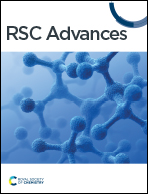Effects of fluorine bonding and nonbonding interactions on 19F chemical shifts†
Abstract
19
F-NMR signals are sensitive to local electrostatic fields and are useful in probing protein structures and dynamics. Here, we used chemically identical ortho-F nuclei in N-phenyl γ-lactams to investigate the relationship between 19F NMR chemical shifts and local environments. By varying the structures at the C5- and C7-substituents, we demonstrated that 19F shifts and Hammett coefficients in Hammett plots follow typical relationships in bonding interactions, while manifesting reverse correlations in nonbonding contacts. Quantum mechanics calculations revealed that one of the ortho-F nuclei engages in n → π* orbital delocalization between F lone pair electrons (n) and a C![[double bond, length as m-dash]](https://www.rsc.org/images/entities/char_e001.gif) O/Ar
O/Ar![[double bond, length as m-dash]](https://www.rsc.org/images/entities/char_e001.gif) N antibonding orbital (π*), and the other ortho-F nucleus exhibits n ↔ σ orbital polarization between the n electrons and the C–H σ bonding orbital. As 19F NMR spectroscopy find increasing use in molecular sensors and biological sciences, our findings are valuable for designing sensitive probes, elucidating molecular structures, and quantifying analytes.
N antibonding orbital (π*), and the other ortho-F nucleus exhibits n ↔ σ orbital polarization between the n electrons and the C–H σ bonding orbital. As 19F NMR spectroscopy find increasing use in molecular sensors and biological sciences, our findings are valuable for designing sensitive probes, elucidating molecular structures, and quantifying analytes.



 Please wait while we load your content...
Please wait while we load your content...